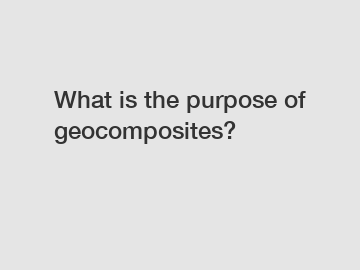What is the purpose of geocomposites?
In the world of civil engineering, geocomposites have emerged as invaluable tools that offer innovative solutions to various challenges faced in infrastructure development. These multidimensional materials have revolutionized the industry, allowing engineers to overcome complex geotechnical issues efficiently. Their purpose goes far beyond conventional solutions, presenting an incredible range of applications that harness their unique characteristics. In this blog, we will delve into the purpose of geocomposites, exploring their high efficiency, versatility, and the positive impact they have had on modern construction projects.
Section 1: Understanding Geocomposites.
Before we dive into the purpose, let's take a moment to understand what geocomposites are. Geocomposites are engineered materials that combine different geosynthetic components, such as geotextiles, geomembranes, geonets, and geogrids, to form a single composite product. These combinations impart unique properties and functions that enhance their performance and enable them to address complex geotechnical challenges effectively.

Section 2: Versatility in Geotechnical Engineering.
One of the primary purposes of geocomposites is their remarkable versatility in geotechnical engineering. From erosion control and soil stabilization to drainage systems and waterproofing, geocomposites can be tailored to meet diverse project requirements. This adaptability makes them suitable for a wide range of applications, including highway construction, landfill engineering, coastal protection, embankment reinforcement, and many more.
Section 3: Enhanced Efficiency.
Geocomposites offer a high level of efficiency due to their ability to integrate multiple functions within a single product. For instance, a geocomposite can simultaneously provide separation, filtration, and reinforcement, eliminating the need for separate installations. This streamlined approach not only saves time but also reduces construction costs significantly. With geocomposites, engineers can optimize project timelines while ensuring superior performance.
Section 4: Mitigating Geotechnical Challenges.
Geotechnical challenges, such as poor soil conditions, high water tables, and uneven terrain, can hinder construction projects. Geocomposites are designed to address these challenges by providing soil stabilization, drainage, and reinforcement. By enhancing soil strength and improving drainage, they can stabilize embankments, retain walls, and slopes, creating a safer and more durable environment.
Section 5: Environmental Benefits.
In addition to their engineering prowess, geocomposites offer substantial environmental benefits. They minimize soil erosion, prevent the migration of pollutants, and contribute to the preservation of natural habitats. The use of geocomposites in environmental applications, like liners for landfills or remediation of contaminated sites, showcases the ecological responsibility that they bring to construction projects.
Section 6: Groundwater Management and Pollution Control.
An important purpose of geocomposites is their ability to manage groundwater and control pollution. They act as effective barriers against contaminant migration, providing a protective layer between pollutants and the surrounding environment. Geocomposites also enable efficient groundwater control, facilitating its collection and preventing harmful seepage into sensitive areas. This purpose makes them indispensable in areas prone to high water tables or pollution risks.
Section 7: Geocomposites' Future: Advancements and Innovations.
Geocomposites continue to evolve as researchers and engineers explore new possibilities. Ongoing advancements include the integration of smart materials, improved mechanical characteristics, and advanced manufacturing techniques. These developments promise even greater efficiency, sustainability, and resilience in the future of geocomposites, expanding their scope and impact across various construction sectors.
Conclusion:
Geocomposites have become a game-changer in the field of civil engineering, with their purpose reaching far beyond conventional solutions. Their versatility, enhanced efficiency, ability to mitigate geotechnical challenges, environmental benefits, groundwater management capabilities, and ongoing advancements make them invaluable tools for modern construction projects. As the industry continues to innovate, geocomposites will undoubtedly play a crucial role in building sustainable and resilient infrastructure for years to come.
The company is the world’s best trp geomembranes, ldpe smooth geomembrane specifications, geotextile for iraq manufacturer supplier. We are your one-stop shop for all needs. Our staff are highly-specialized and will help you find the product you need.

Comments
0